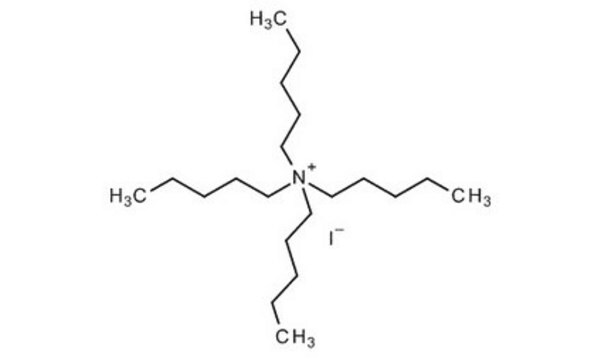87997
Tetrapentylammonium bromide
suitable for ion pair chromatography, LiChropur™, ≥99.0% (AT)
About This Item
Recommended Products
description
cationic
Quality Level
Assay
≥99.0% (AT)
form
powder
quality
LiChropur™
technique(s)
ion pair chromatography: suitable
mp
100-101 °C (lit.)
λ
10 % in methanol
UV absorption
λ: 240 nm Amax: 0.04
λ: 250 nm Amax: 0.03
λ: 260 nm Amax: 0.02
λ: 500 nm Amax: 0.02
suitability
corresponds to standard for filter test
SMILES string
[Br-].CCCCC[N+](CCCCC)(CCCCC)CCCCC
InChI
1S/C20H44N.BrH/c1-5-9-13-17-21(18-14-10-6-2,19-15-11-7-3)20-16-12-8-4;/h5-20H2,1-4H3;1H/q+1;/p-1
InChI key
SPALIFXDWQTXKS-UHFFFAOYSA-M
Looking for similar products? Visit Product Comparison Guide
Related Categories
General description
Application
Other Notes
Legal Information
Signal Word
Warning
Hazard Statements
Precautionary Statements
Hazard Classifications
Eye Irrit. 2 - Skin Irrit. 2 - STOT SE 3
Target Organs
Respiratory system
Storage Class Code
11 - Combustible Solids
WGK
WGK 3
Flash Point(F)
Not applicable
Flash Point(C)
Not applicable
Personal Protective Equipment
Regulatory Listings
Regulatory Listings are mainly provided for chemical products. Only limited information can be provided here for non-chemical products. No entry means none of the components are listed. It is the user’s obligation to ensure the safe and legal use of the product.
JAN Code
87997-BULK-F:
87997-VAR-F:
87997-10G-F:
87997-10G:
Choose from one of the most recent versions:
Already Own This Product?
Find documentation for the products that you have recently purchased in the Document Library.
Our team of scientists has experience in all areas of research including Life Science, Material Science, Chemical Synthesis, Chromatography, Analytical and many others.
Contact Technical Service







